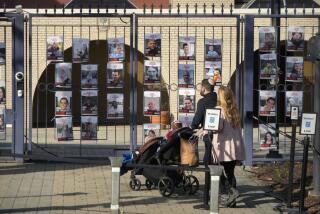Edward G. Uhl dies at 92; co-inventor of the bazooka
Edward G. Uhl, former president of Fairchild Industries who was co-inventor of the M1 bazooka during World War II, died Sunday of heart failure at an assisted living facility in Easton, Md. He was 92.
Uhl, pronounced “Yule,” served as a regular officer in the Army’s Ordnance Corps from 1941 until 1946. In 1942, while assigned to Ordnance Corps headquarters at the Pentagon in Washington, he helped develop the first U.S. shoulder-launched bazooka, which was originally named the M1 Rocket Launcher, with Col. Leslie A. Skinner.
“When I met with Skinner, he was working on rockets. We really had no anti-tank weapon. You can’t believe how inept our military was at that point in time,” Uhl said in a 2007 interview with Maryland Cracker Barrel Magazine.
“Skinner said, ‘I’m going to be working on rockets to be located on aircraft, and I want you to take this rocket grenade. I think we can probably make a rocket out of this grenade and have it be an effective weapon, so that’s your job,’ ” Uhl recalled. “The weapon that I was working on finally developed into what was known as the bazooka.”
Uhl faced two immediate problems: How would a soldier aim the weapon and how would the burning powder be kept from coming into contact with his face?
“One day I was walking by this scrap pile, and there was a tube that was 5 feet long and 60 mm in diameter, which happened to be the same size as the grenade that we were turning into a rocket,” Uhl said in the interview. “I said, ‘That’s the answer! Put the tube on a soldier’s shoulder with the rocket inside and away it goes.’ ”
During field trials at the Aberdeen Proving Ground in Maryland, the M1 rocket launcher successfully blew the turret off a tank and its M6 rocket penetrated armor plate that was more than 4 inches thick.
Later during World War II, Uhl joined the staff of Gen. Douglas MacArthur in the Pacific. After resigning his commission in 1946 with the rank of lieutenant colonel, he went to work for the old Glenn L. Martin Co. in Middle River, Md., where he was a member of a team that was directing the company’s move into the new field of rockets.
In 1949, he was named head of “pilotless aircraft” — or what is now known as guided missiles — and helped design the Viking high-altitude research rocket and the Air Force Matador.
Rising through the ranks, Uhl was named vice president of engineering in 1952 and later became vice president and general manager of Martin’s plant in Orlando, Fla.
During his years in Orlando, Uhl oversaw the development and manufacture of the LaCrosse, Bullpup and Pershing missiles.
After leaving Martin in 1959, he was general manager and vice president of technical administration for two years at Ryan Aeronautical Co. in San Diego.
In 1961, he was named president of Fairchild Engine and Airplane Corp., later Fairchild Industries Inc., in Hagerstown, Md.
During Uhl’s years at Fairchild, one of his great successes was the building of what was called a “close air support aircraft” — later the A-10 Warthog — which featured jet engines rather than turbo props. Beating out the competition, Fairchild got a $40-million contract from the Defense Department to build the new planes. Uhl retired in 1985.
Born in 1918 in Elizabeth, N.J., the son of a mechanic and a homemaker, Uhl earned a bachelor’s degree in engineering physics in 1940 from Lehigh University, where he had been a member of Phi Beta Kappa.
Uhl’s survivors include his wife of 44 years, the former Mary Stuart Brugh; two sons, a daughter, two stepsons, four grandchildren and five step-grandchildren.
More to Read
Start your day right
Sign up for Essential California for the L.A. Times biggest news, features and recommendations in your inbox six days a week.
You may occasionally receive promotional content from the Los Angeles Times.






